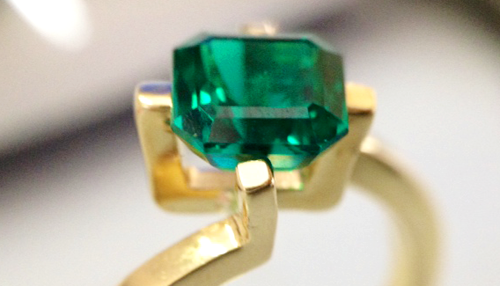Emerald
Emerald is a variety of beryl occurring in various shades of green and is one of the most valuable stones found in nature. It crystallizes in the hexagonal system and has a refractive index of 1.577 to 1.583 (±0.017) and a 2.72 (+0.18, -0.05) specific gravity. Its hardness is 7.5 to 8 on the Moh's scale. Most emeralds are highly included and posses a poor resistance to breakage.
The green color in beryl is caused by Chromium and/or Vanadium. Some old practices limit the definition of emerald to the chromium-bearing green varieties only, while the majority of traders define it according to the intensity of the color, regardless of its coloring element. The less saturated green-colored gems are defined as Green Beryls, which have a much lower value.
Emerald is the birthstone for the month of May and the gemstone representing the 20th, 35th, and 55th wedding anniversaries.
From the very dawn of history, it has been coveted and worshipped. Emeralds were once prescribed for eye diseases and were attributed to improve weak eyesight because the green color was believed to be soothing to the eyes. It was also once recommended as an amulet to ward off epilepsy in children. Emeralds were known to strengthen the owner's memory, quicken intelligence, and assist in predicting the future, and also known as a symbol of rebirth and romance.

Emerald ring
Emerald was credited with amazing powers against wickedness and deceit, and was even thought to be capable of blinding and killing snakes.
The oldest known source of emeralds is the Cleopatra Mine in ancient Egypt, located on the Red Sea. These mines were the source of all the emeralds that appeared in the ancient world.
Another ancient mine which was already in existence during Roman times is the Habachtal Mine in the Austrian Alps.
Other ancient sources of emeralds are mines in India, the most famous of the known locations is the Ajmer Merwara Mine.
Emeralds from the Colombian mines were used for ceremonial and decorative purposes for centuries by the indigenous population. The conquistadors learned of the gemstones' existence in 1537, after the naive tribesmen offered them up as gifts. In Columbia today, there are two principal mining regions. The first is the Muzo area, located about 113 km from the capital Bogota, and the second is the Chivor region, which lies about 80 km northeast of the city. Both areas include several large emerald-producing mines.
Zambia is, without a doubt one of the most important sources of emeralds. The mines are located in northern Zambia, between the city of Kitwe and the city of Ndola. The largest and most important of the Zambian mines is the Kamakanga mine.
Brazil possess a number of emerald mines in the states of Bahia, Minas Gerais and Goias. In 1963, the Carnaiba mountains were also found to yield high-quality stones.
The Russian emerald-producing mines are concentrated in the Ural Mountains, within 100 km from the city of Sverdlovsk. The most famous mine is the Takowaya, which was discovered in 1830, 45 km from the city.
South Africa was the first country in Africa in which emeralds were discovered in the Northeastern Transvaal.
The best-known emeralds from Zimbabwe are the mines of the Sandawana valley, which yield beautiful stones that have acquired a place of honor among the most valuable of emeralds. Other mines are in Fort Victoria, the Filabushi region, the Balgoi region, the Bastari region and in Makanga.
Tanzania produced excellent quality emeralds alongside Lake Manyara.
Emeralds from Afghanistan are renowned, among dealers and jewelers alike, for their fine-quality color, which equals the finest emeralds from Muzo in Colombia and Kamakanga in Zambia. The mines are located in the Panjshir valley.
Emeralds from Pakistan are concentrated in the Swat District. Four main deposits are known to produce gem-quality emeralds: the Mingora deposit, the Gujar Killi, and the Barang and Khaltaro deposits.
| Gemological Properties: | |
| Species: | Beryl |
| Chemical composition: | Be3Al2(SiO3)6 |
| Crystal system: | Hexagonal |
| Hardness: | 7.5 to 8 |
| Color: | Green |
| Optic sign: | DR Uniaxial |
| Refractive Index: | 1.577 to 1.583 (±0.017) |
| Specific Gravity: | 2.72 (+0.18, -0.05) |
| Enhancements: | O-Oiling/Resin Infusion, F-Filling, D-Dyeing |

